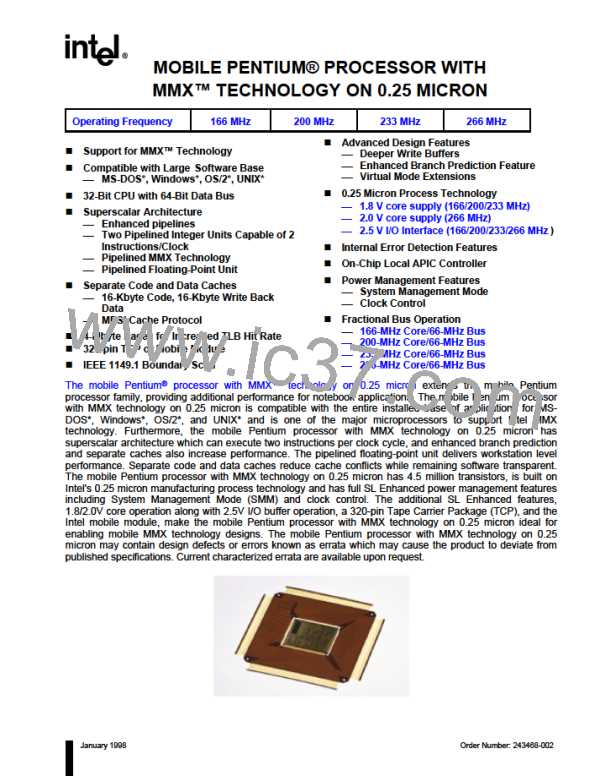®
MOBILE PENTIUM PROCESSOR WITH MMX™ TECHNOLOGY
where,
6.0. THERMAL SPECIFICATIONS
T
A
and T are ambient and case temperatures (°C)
C
q
q
q
= Case-to-Ambient thermal resistance (°C/W)
= Junction-to-Ambient thermal resistance (°C/W)
= Junction-to-Case thermal resistance (°C/W)
CA
JA
JC
The mobile Pentium processor with MMX
technology on 0.25 Micron is specified for proper
operation when the case temperature, TCASE (TC),
for TCP is within the specified range of 0 °C to 95
°C.
P = maximum power consumption (Watts)
P (maximum power consumption) is specified in
Section 3.1.
6.1.
Measuring Thermal Values for
TCP
6.1.2.
TCP Thermal Characteristics
To verify that the proper TC (case temperature) is
maintained, it should be measured at the center of
the package top surface (encapsulant). To minimize
any measurement errors, the following techniques
are recommended:
The primary heat transfer path from the die of the
TCP is through the back side of the die and into the
PC board. There are two thermal paths traveling
from the PC board to the ambient air. One is the
spread of heat within the board and the dissipation
of heat by the board to the ambient air. The other is
the transfer of heat through the board and to the
opposite side where thermal enhancements (e.g.,
heat sinks, pipes) are attached. Solder-side heat
sinking, compared to TCP component-side heat
sinking, is the preferred method due to reduced risk
of die damage, easier mechanical implementation
and larger surface area for attachment. However,
component-side heat sinking is possible. The
design requirements in a component-side thermal
solution are: no direct loading of inner lead bonds
on the TCP, a maximum force of 4.5 kgf on the
center of a clean TCP, no direct loading of the TAB
tape or outer lead bonds and controlled board
deflection.
·
Use 36 gauge or finer diameter K, T, or J type
thermocouples. Intel's laboratory testing was
done using a thermocouple made by Omega
(part number: 5TC-TTK-36-36).
·
Attach the thermocouple bead or junction to the
center of the package top surface using highly
thermally conductive cements. Intel's laboratory
testing was done by using Omega Bond* (part
number: OB-100).
·
The thermocouple should be attached at a
90° angle as shown in Figure 23.
6.1.1.
TCP Thermal Equations
For the TCP mobile Pentium processor with MMX
technology, an ambient temperature (TA) is not
specified directly. The only requirement is that the
case temperature (TC) is met. The ambient
temperature can be calculated from the following
equations:
6.1.3.
TCP PC Board Enhancements
Copper planes, thermal pads, and vias are design
options that can be used to improve heat transfer
from the PC board to the ambient air. Tables 26
and 27 present thermal resistance data for copper
plane thickness and via effects. It should be noted
that although thicker copper planes will reduce the
qca of a system without any thermal enhancements,
they have less effect on the qca of a system with
thermal enhancements. However, placing vias
under the die will reduce the qca of a system with
and without thermal enhancements.
TJ = TC + P ´ qJC
TA = TJ - P ´ qJA
TA = TC - (P ´ qCA)
TC = TA + P ´ qJA - qJC
[
]
qCA = qJA - qJC
64

 INTEL [ INTEL ]
INTEL [ INTEL ]